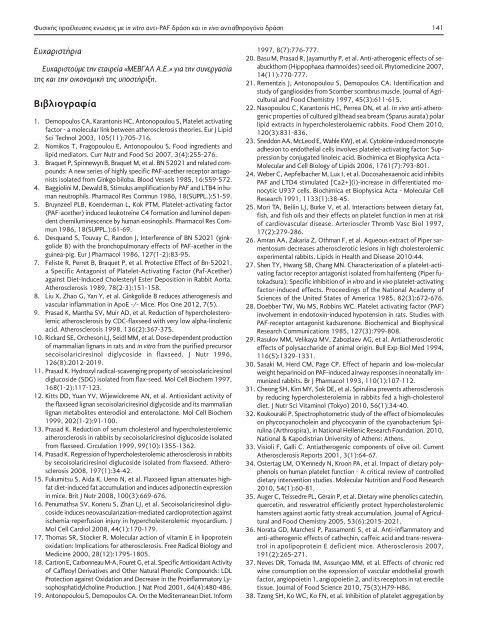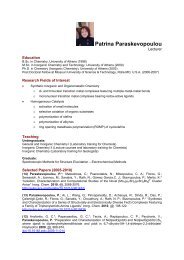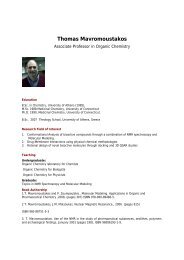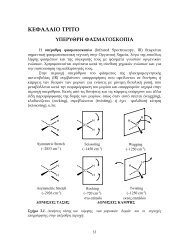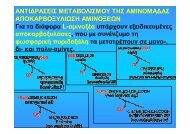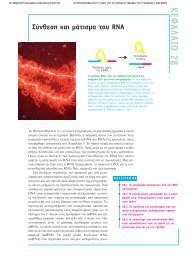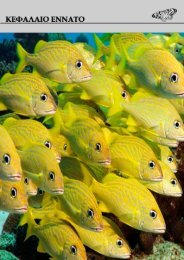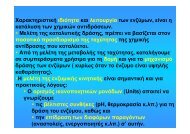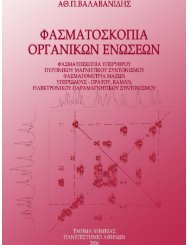ÎαÏδιολογική ÎνÏμη - ÎÎ¸Î½Î¹ÎºÏ ÎºÎ±Î¹ ÎαÏοδιÏÏÏÎ¹Î±ÎºÏ Î Î±Î½ÎµÏιÏÏήμιο ...
ÎαÏδιολογική ÎνÏμη - ÎÎ¸Î½Î¹ÎºÏ ÎºÎ±Î¹ ÎαÏοδιÏÏÏÎ¹Î±ÎºÏ Î Î±Î½ÎµÏιÏÏήμιο ...
ÎαÏδιολογική ÎνÏμη - ÎÎ¸Î½Î¹ÎºÏ ÎºÎ±Î¹ ÎαÏοδιÏÏÏÎ¹Î±ÎºÏ Î Î±Î½ÎµÏιÏÏήμιο ...
- No tags were found...
Create successful ePaper yourself
Turn your PDF publications into a flip-book with our unique Google optimized e-Paper software.
Φυσικής προέλευσης ενώσεις με in vitro αντι-PAF δράση και in vivo αντιαθηρογόνο δράση141ΕυχαριστήριαΕυχαριστούμε την εταιρεία «ΜΕΒΓΑΛ Α.Ε.» για την συνεργασίατης και την οικονομική της υποστήριξη.Bιβλιογραφία1. Demopoulos CA, Karantonis HC, Antonopoulou S, Platelet activatingfactor - a molecular link between atherosclerosis theories. Eur J LipidSci Technol 2003, 105(11):705-716.2. Nomikos T, Fragopoulou E, Antonopoulou S, Food ingredients andlipid mediators. Curr Nutr and Food Sci 2007, 3(4):255-276.3. Braquet P, Spinnewyn B, Braquet M, et al. BN 52021 and related compounds:A new series of highly specific PAF-acether receptor antagonistsisolated from Ginkgo biloba. Blood Vessels 1985, 16:559-572.4. Baggiolini M, Dewald B, Stimulus amplification by PAF and LTB4 in humanneutrophils. Pharmacol Res Commun 1986, 18(SUPPL.):51-59.5. Bruynzeel PLB, Koenderman L, Kok PTM, Platelet-activating factor(PAF-acether) induced leukotreine C4 formation and luminol dependentchemiluminescence by human eosinophils. Pharmacol Res Commun1986, 18(SUPPL.):61-69.6. Desquand S, Touvay C, Randon J, Interference of BN 52021 (ginkgolideB) with the bronchopulmonary effects of PAF-acether in theguinea-pig. Eur J Pharmacol 1986, 127(1-2):83-95.7. Feliste R, Perret B, Braquet P, et al. Protective Effect of Bn-52021,a Specific Antagonist of Platelet-Activating Factor (Paf-Acether)against Diet-Induced Cholesteryl Ester Deposition in Rabbit Aorta.Atherosclerosis 1989, 78(2-3):151-158.8. Liu X, Zhao G, Yan Y, et al. Ginkgolide B reduces atherogenesis andvascular inflammation in ApoE -/- Mice. Plos One 2012, 7(5).9. Prasad K, Mantha SV, Muir AD, et al. Reduction of hypercholesterolemicatherosclerosis by CDC-flaxseed with very low alpha-linolenicacid. Atherosclerosis 1998, 136(2):367-375.10. Rickard SE, Orcheson LJ, Seidl MM, et al. Dose-dependent productionof mammalian lignans in rats and in vitro from the purified precursorsecoisolariciresinol diglycoside in flaxseed. J Nutr 1996,126(8):2012-2019.11. Prasad K. Hydroxyl radical-scavenging property of secoisolariciresinoldiglucoside (SDG) isolated from flax-seed. Mol Cell Biochem 1997,168(1-2):117-123.12. Kitts DD, Yuan YV, Wijewickreme AN, et al. Antioxidant activity ofthe flaxseed lignan secoisolariciresinol diglycoside and its mammalianlignan metabolites enterodiol and enterolactone. Mol Cell Biochem1999, 202(1-2):91-100.13. Prasad K. Reduction of serum cholesterol and hypercholesterolemicatherosclerosis in rabbits by secoisolariciresinol diglucoside isolatedfrom flaxseed. Circulation 1999, 99(10):1355-1362.14. Prasad K. Regression of hypercholesterolemic atherosclerosis in rabbitsby secoisolariciresinol diglucoside isolated from flaxseed. Atherosclerosis2008, 197(1):34-42.15. Fukumitsu S, Aida K, Ueno N, et al. Flaxseed lignan attenuates highfatdiet-induced fat accumulation and induces adiponectin expressionin mice. Brit J Nutr 2008, 100(3):669-676.16. Penumathsa SV, Koneru S, Zhan LJ, et al. Secoisolariciresinol diglucosideinduces neovascularization-mediated cardioprotection againstischemia-reperfusion injury in hypercholesterolemic myocardium. JMol Cell Cardiol 2008, 44(1):170-179.17. Thomas SR, Stocker R. Molecular action of vitamin E in lipoproteinoxidation: Implications for atherosclerosis. Free Radical Biology andMedicine 2000, 28(12):1795-1805.18. Cartron E, Carbonneau M-A, Fouret G, et al. Specific Antioxidant Activityof Caffeoyl Derivatives and Other Natural Phenolic Compounds: LDLProtection against Oxidation and Decrease in the Proinflammatory LysophosphatidylcholineProduction. J Nat Prod 2001, 64(4):480-486.19. Antonopoulou S, Demopoulos CA. On the Mediterranean Diet. Inform1997, 8(7):776-777.20. Basu M, Prasad R, Jayamurthy P, et al. Anti-atherogenic effects of seabuckthorn(Hippophaea rhamnoides) seed oil. Phytomedicine 2007,14(11):770-777.21. Rementzis J, Antonopoulou S, Demopoulos CA. Identification andstudy of gangliosides from Scomber scombrus muscle. Journal of Agriculturaland Food Chemistry 1997, 45(3):611-615.22. Nasopoulou C, Karantonis HC, Perrea DN, et al. In vivo anti-atherogenicproperties of cultured gilthead sea bream (Sparus aurata) polarlipid extracts in hypercholesterolaemic rabbits. Food Chem 2010,120(3):831-836.23. Sneddon AA, McLeod E, Wahle KWJ, et al. Cytokine-induced monocyteadhesion to endothelial cells involves platelet-activating factor: Suppressionby conjugated linoleic acid. Biochimica et Biophysica Acta -Molecular and Cell Biology of Lipids 2006, 1761(7):793-801.24. Weber C, Aepfelbacher M, Lux I, et al. Docosahexaenoic acid inhibitsPAF and LTD4 stimulated [Ca2+](i)-increase in differentiated monocyticU937 cells. Biochimica et Biophysica Acta - Molecular CellResearch 1991, 1133(1):38-45.25. Mori TA, Beilin LJ, Burke V, et al. Interactions between dietary fat,fish, and fish oils and their effects on platelet function in men at riskof cardiovascular disease. Arterioscler Thromb Vasc Biol 1997,17(2):279-286.26. Amran AA, Zakaria Z, Othman F, et al. Aqueous extract of Piper sarmentosumdecreases atherosclerotic lesions in high cholesterolemicexperimental rabbits. Lipids in Health and Disease 2010:44.27. Shen TY, Hwang SB, Chang MN. Characterization of a platelet-activatingfactor receptor antagonist isolated from haifenteng (Piper futokadsura):Specific inhibition of in vitro and in vivo platelet-activatingfactor-induced effects. Proceedings of the National Academy ofSciences of the United States of America 1985, 82(3):672-676.28. Doebber TW, Wu MS, Robbins WC. Platelet activating factor (PAF)involvement in endotoxin-induced hypotension in rats. Studies withPAF-receptor antagonist kadsurenone. Biochemical and BiophysicalResearch Communications 1985, 127(3):799-808.29. Rasulov MM, Velikaya MV, Zabozlaev AG, et al. Antiatheroscleroticeffects of polysaccharide of animal origin. Bull Exp Biol Med 1994,116(5):1329-1331.30. Sasaki M, Herd CM, Page CP. Effect of heparin and low-molecularweight heparinoid on PAF-induced airway responses in neonatally immunizedrabbits. Br J Pharmacol 1993, 110(1):107-112.31. Cheong SH, Kim MY, Sok DE, et al. Spirulina prevents atherosclerosisby reducing hypercholesterolemia in rabbits fed a high-cholesteroldiet. J Nutr Sci Vitaminol (Tokyo) 2010, 56(1):34-40.32. Koukouraki P. Spectrophotometric study of the effect of biomoleculeson phycocyanocholein and phycocyanin of the cyanobacterium Spirulina(Arthrospira), in National Hellenic Research Foundation. 2010,National & Kapodistrian University of Athens: Athens.33. Visioli F, Galli C. Antiatherogenic components of olive oil. CurrentAtherosclerosis Reports 2001, 3(1):64-67.34. Ostertag LM, O’Kennedy N, Kroon PA, et al. Impact of dietary polyphenolson human platelet function - A critical review of controlleddietary intervention studies. Molecular Nutrition and Food Research2010, 54(1):60-81.35. Auger C, Teissedre PL, Gérain P, et al. Dietary wine phenolics catechin,quercetin, and resveratrol efficiently protect hypercholesterolemichamsters against aortic fatty streak accumulation. Journal of Agriculturaland Food Chemistry 2005, 53(6):2015-2021.36. Norata GD, Marchesi P, Passamonti S, et al. Anti-inflammatory andanti-atherogenic effects of cathechin, caffeic acid and trans-resveratrolin apolipoprotein E deficient mice. Atherosclerosis 2007,191(2):265-271.37. Neves DR, Tomada IM, Assunçao MM, et al. Effects of chronic redwine consumption on the expression of vascular endothelial growthfactor, angiopoietin 1, angiopoietin 2, and its receptors in rat erectiletissue. Journal of Food Science 2010, 75(3):H79-H86.38. Tzeng SH, Ko WC, Ko FN, et al. Inhibition of platelet aggregation by


